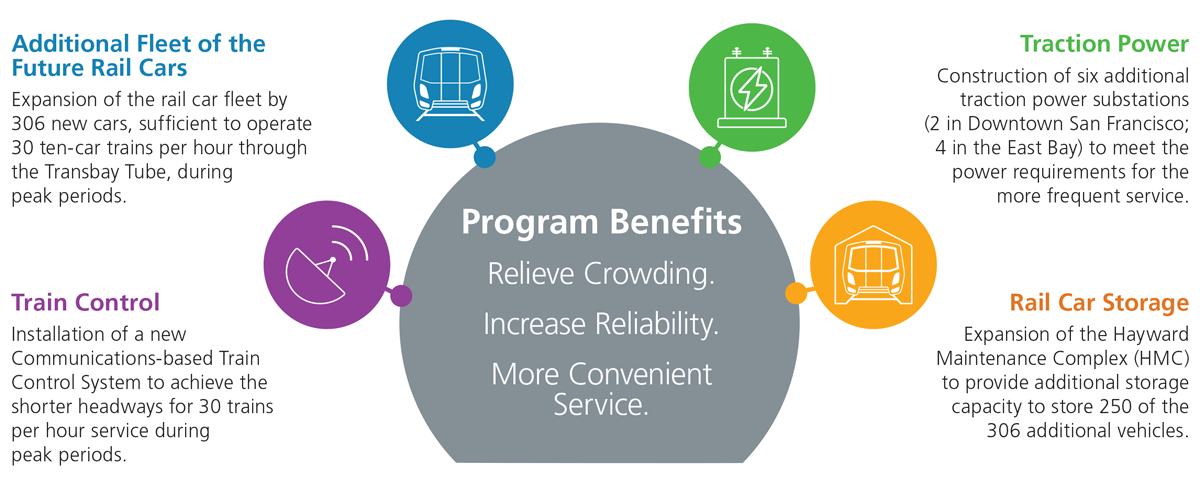
The Transbay Corridor Core Capacity Program is a package of strategic investments that will allow BART to operate up to 30 ten-car trains per hour (300 cars) in each direction through the existing tube, maximizing throughput in the most heavily used part of its system. The program includes four elements: 306 additional railcars to provide the additional trains needed, a new communications-based train control system that will allow closer headways (shorter wait times between trains), a new railcar storage yard at the Hayward Maintenance Complex (Phase 2), and additional traction power substations to provide the additional power needed for the more frequent service.
BART currently has the capacity to operate a maximum of 24 trains per hour in each direction through the Transbay Tube between San Francisco and Oakland. Long-term ridership trends at BART require additional capacity, which has long been recognized across the region. As the system expands and as the core continues to attract development, further increases in ridership are expected.
On September 14, 2020, BART entered into a Full Funding Grant Agreement (FFGA) with the Federal Transit Administration (FTA) for a $1.17 billion Capital Investment Grant (CIG) to help fund the Transbay Corridor Core Capacity Project. The Systemwide Core Capacity Program is a $3.5 billion program, which will expand capacity throughout the entire BART system. The FTA is helping to fund the Transbay Corridor Core Capacity Project, a portion of the systemwide program, which will expand capacity through the Transbay Tube to 28 trains per hour by 2030. The Transbay Corridor Core Capacity Project is a $2.7 billion project, which will be funded by the $1.17 billion FTA CIG grant along with $1.53 million in local, state, and regional matching funds.
Transbay Corridor Core Capacity Program: Summary Schedule
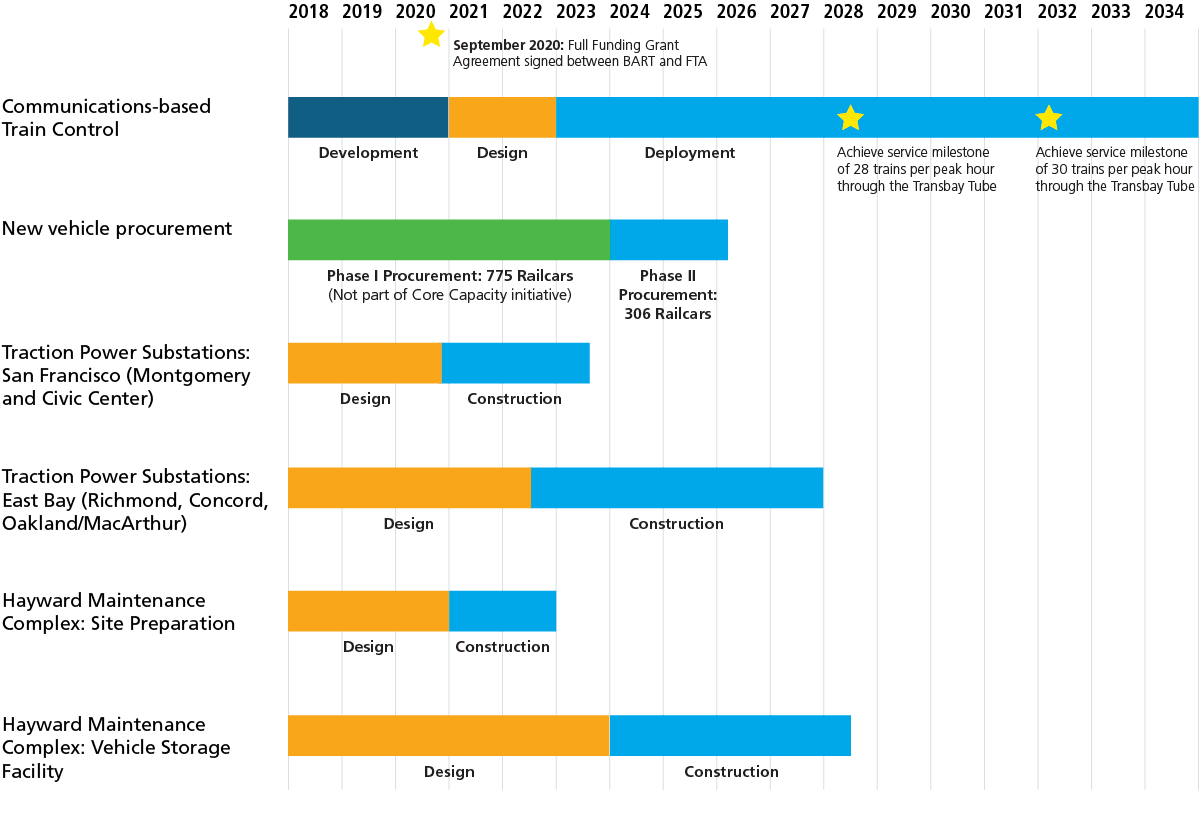
306 Additional Railcars
In order for BART to achieve a peak-hour schedule of 30 ten-car trains through the corridor, BART will require additional cars to make up the added trains and to make longer trains.
In July 2024, the final car of the original 775-car contract was certified as ready for service. With all 775 of the cars from the original contract now on board, BART is renewing its focus on the delivery and certification of an additional 306 rail cars for the Transbay Corridor Core Capacity Program.
Of the 306 additional cars required, 252 are needed for BART to operate 28 ten-car trains per hour on the four lines (Red, Blue, Green and Yellow) that operate through the Transbay Tube to meet the CIG program goals, and ultimately to run up to 30 trains per hour. The remaining 54 railcars are to increase capacity on the Orange Line, which does not operate through the Transbay Tube, and to increase ready reserve trains, which are needed in case delays occur.
An additional 48 cars, which will follow the 306 CCP cars, will serve Phase II of BART to Silicon Valley (BSVII) in the coming decades. The CCP cars and BSVII cars will bring BART’s total fleet to 1,129 rail cars.
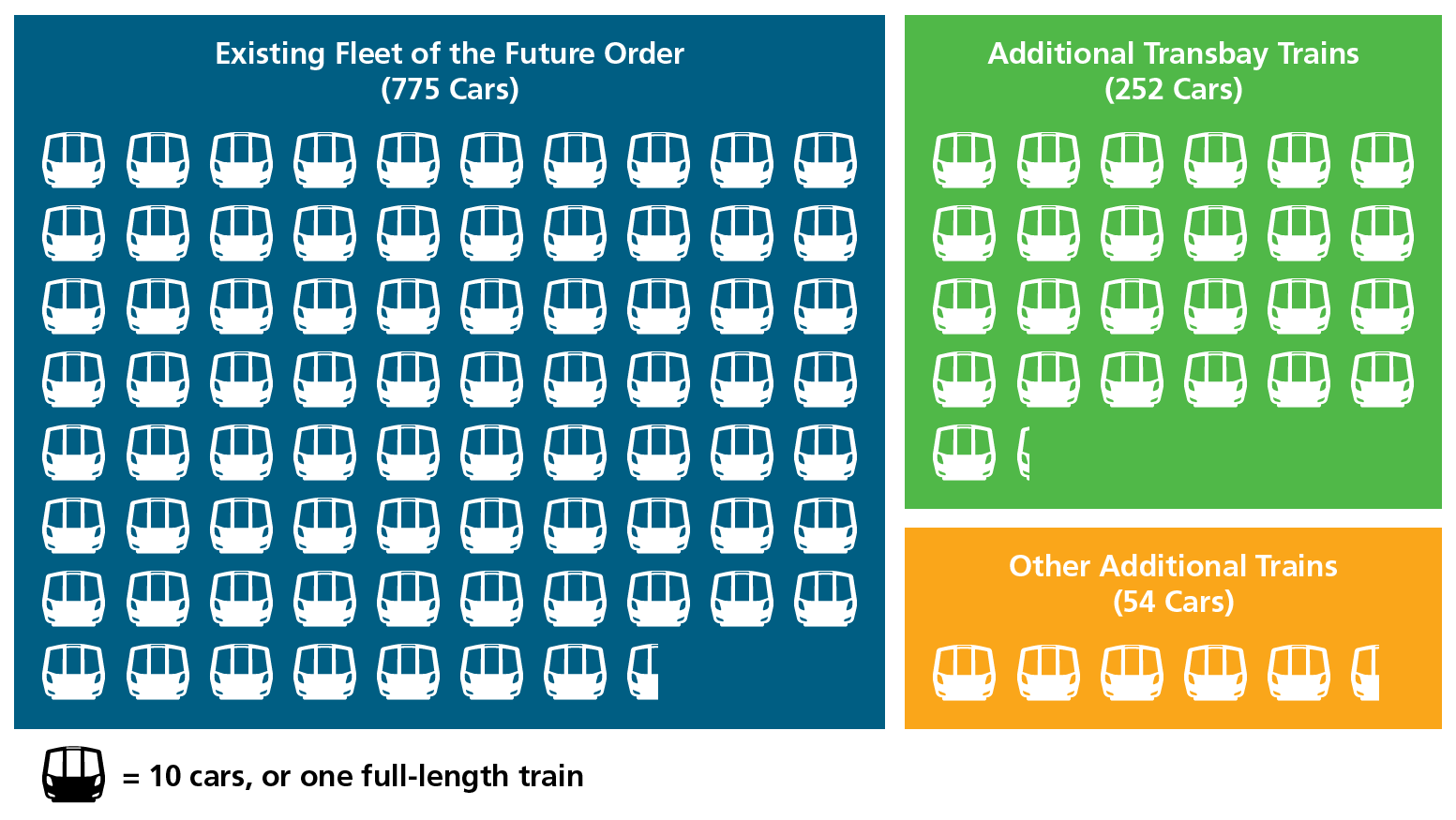
Train Control Modernization Project (Communications-Based Train Control)
To achieve the shorter headways needed to operate 30 peak hour trains per hour through the Transbay Tube, BART will replace its existing fixed-block train control systems with a new, industry-proven Communications Based Train Control System (CBTC). BART has developed a multi-phase implementation program that will begin by testing CBTC equipment on BART’s existing test track in Hayward, and then once the CBTC equipment has been sufficiently proven on test tracks, BART will implement CBTC along the mainline tracks in stages. The scope of the CBTC project includes installation of lineside equipment within BART’s existing right-of-way throughout the entire system. CBTC allows trains to safely operate closer together than the current fixed-block train control system, thus increasing throughput and capacity. CBTC has been implemented on many of the busiest rail systems in Europe and Asia and is now the worldwide standard for high-capacity transit train control.
On January 9, 2020, the BART Board of Directors voted to award a $798 million contract to Hitachi Rail STS USA, Inc. to design and build a modern Communications Based Train Control System (CBTC) that will dramatically improve future BART service, replacing the current fixed-block train control system, which is 47 years old. CBTC will allow BART to run more trains closer together and significantly enhance Transbay capacity. The contract is the largest single BART award contract in BART history.
Hayward Maintenance Complex, Phase 2
To accommodate the additional new vehicles BART needs for the higher frequency service, BART will build a new storage yard on BART-owned property at the Hayward Maintenance Complex (HMC) The new yard will provide storage for 25 ten-car trains, or 250 additional vehicles.
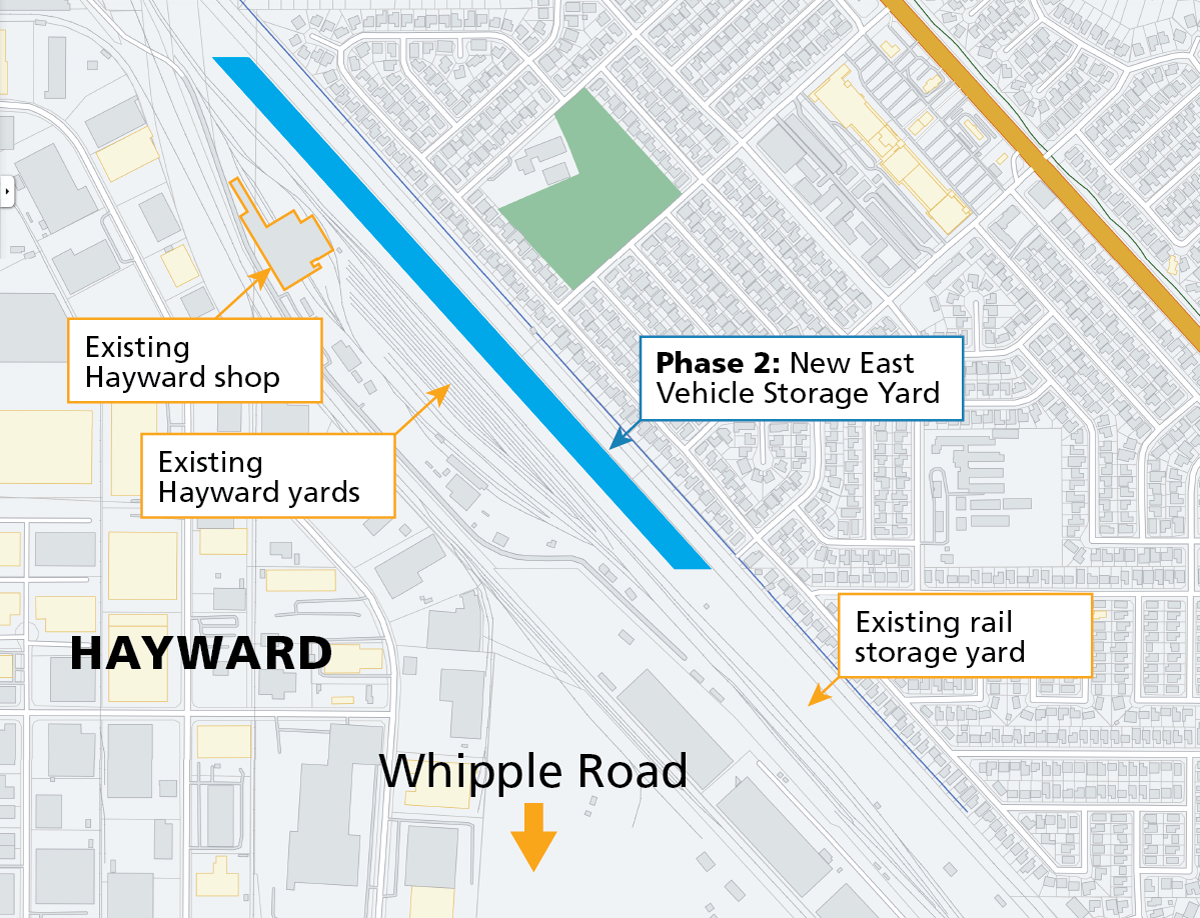
Traction Power Substations
BART’s trains are electrically powered through a third-rail system. With more frequent and longer trains, BART will need the traction power system that supplies electricity to the third rail to be enhanced with several new traction power substations. BART has conducted traction power simulations to assess the power requirements associated with operating 30 regularly scheduled ten-car trains through the Transbay Tube per hour. The simulation revealed specific areas along BART’s mainline where the traction power requirements for the more-frequent service exceed the capacity available from BART’s existing traction power system. Five sites have been identified for new substations:
- Downtown San Francisco—Civic Center Station
- Downtown San Francisco—Montgomery Station
- Oakland—near MacArthur station on 34th Street
- Concord
- Richmond
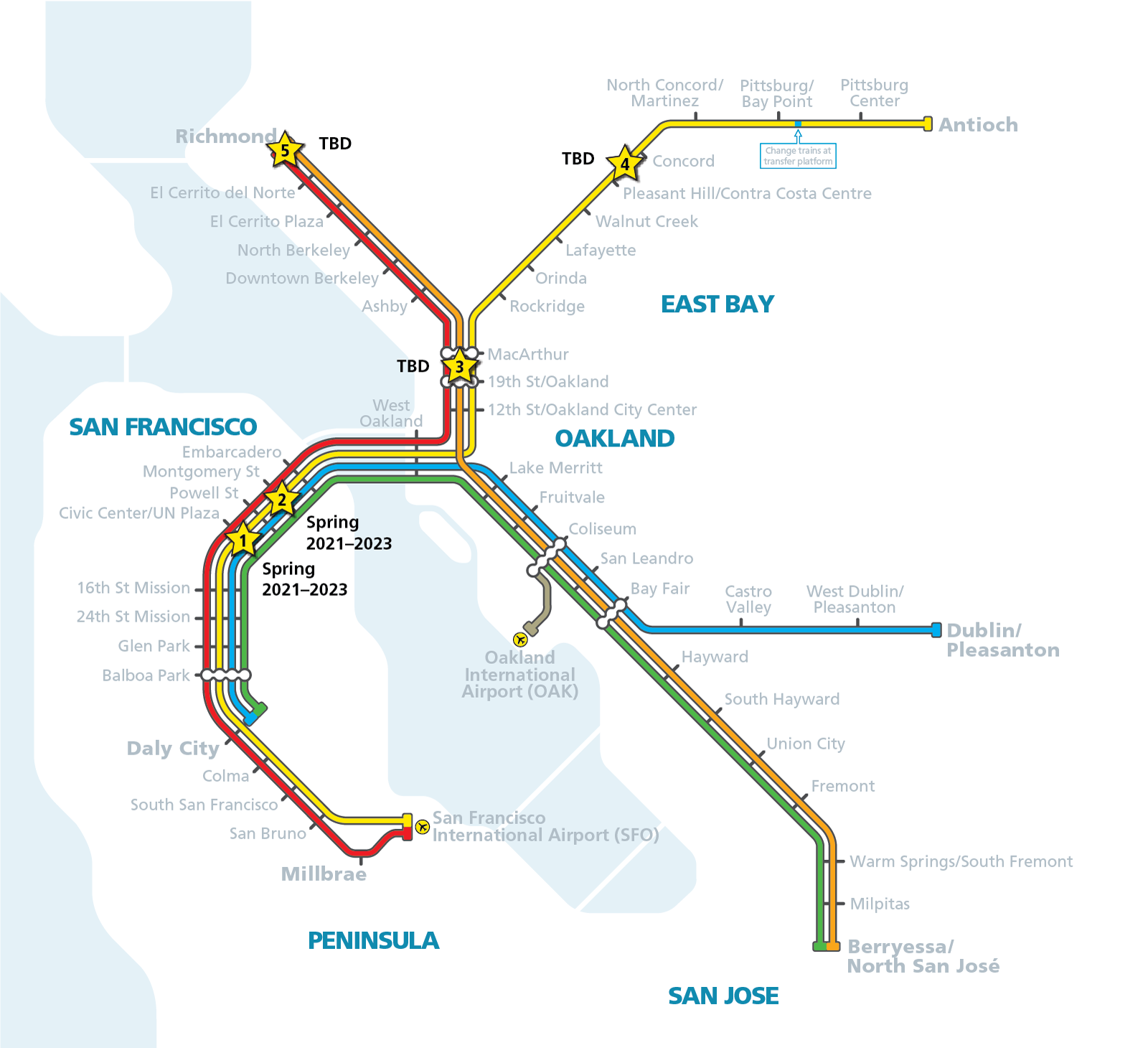
A sixth substation would also be installed at the Hayward Maintenance Complex. The four locations in the East Bay are all within existing BART or Caltrans right-of-way and are at-grade locations. The two sites in San Francisco are located below grade within existing BART stations. BART is also undertaking a major program to replace and upgrade the existing traction power system. While this program will increase the amount of power available for train operation, it is not considered to be part of the Core Capacity Program.
PROJECT DOCUMENT LIBRARY
Environmental Review
The TCCCP received environmental review pursuant to both the California Environmental Quality Act (CEQA) and the National Environmental Policy Act (NEPA). The project was found eligible for a Statutory Exemption (SE) from CEQA on November 17, 2016, and the project received a documented Categorical Exclusion (CE) from FTA for NEPA on October 11, 2017. The links below can be used to access the environmental documents.
NEPA documented Categorical Exclusion Cat Ex
NEPA documented Categorical Exclusion Appendices
Planning
As part of a request to the California Transportation Commission (CTC) for funding for the TCCCP, BART prepared a Hybrid Summary Comprehensive Multimodal Corridor Plan (HSCMCP) per CTC guidelines, to document the regional planning processes supporting the project. The link below can be used to access the plan submitted to CTC.